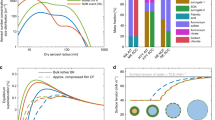Abstract
Photochemical smog formation at the regional scale is a phenomenon of concern in northern America and Europe. It is important to include a treatment of cloud processes in regional photochemical oxidant models because clouds may affect the overall chemistry of regional photochemical oxidant formation. This paper focuses on the development and application of a model that describes the chemistry of oxidant formation in clouds. The model consists of a chemical kinetic mechanism for the gas phase, mass transfer and thermodynamic equilibrium between the bulk gas phase and the cloud droplets, and a detailed chemical kinetic mechanism for the aqueous phase. Model simulations were conducted for typical conditions in the northeastern U.S. using (1) gas-phase chemistry only and (2) gas-phase and cloud droplet chemistry. Comparisons of these two sets of model simulations show that O3 formation is considerably reduced in clouds despite its low solubility. The principal causes of lower O3 formation rates are (1) the high solubility of aldehydes, which are a main source of HO2 radicals, (2) the scavenging of radicals by cloud droplets, and (3) the lower photolytic rates inside the cloud.
Similar content being viewed by others
References
Builtjes, P. J. H., van den Hout, K. D., and Reynolds, S. D.: 1984, ‘Evaluation of the Performance of a Photochemical Dispersion Model in Practical Applications’, in C. de Wispelaere (ed.), Air Pollution Modeling and Its Applications, Vol. 3, Plenum Press, New York, in press.
Damschen, D. E.: 1982, private communication.
Davis, D. D.: 1983, private communication.
Deirmendjian, D.: 1969, Electromagnetic Scattering in Spherical Poly-Dispersions, Elsevier, New York.
EPRI: 1981, ‘Aircraft Measurements of Pollutants and Meteorological Parameters during the Sulfate Regional Experiment (SURE) Program’, Electric Power Research Institute, Palo Alto, California (EPRI Report EA-1909).
Erickson, R. E., Yates, L. M., Clark, R. L., and McEwan, D.: 1977, Atmos. Environ. 11, 813.
Fuchs, N. A. and Sutugin, A. G.: 1971, ‘High-Dispersed Aerosols’, in G. M. Hidy and J. R. Brock (eds.), Topics in Current Aerosol Research, Pergamon Press, New York.
Graedel, T. E. and Goldberg, K. I.: 1983, J. Geophys. Res. 88, 10865.
Gurol, M. D. and Singer, P. C.: 1982, Environ. Sci. Technol. 16, 377.
Hoigne, J. and Bader, H.: 1976, Water Res. 10, 377.
Killus, J. P. and Whitten, G. Z.: 1983, ‘A New Carbon-Bond Mechanism for Air Quality Simulation Modeling’, Systems Applications, Inc. San Rafael, California (SYSAPP-81/245).
Lamb, R. G.: 1982, ‘A Regional-Scale (1000 km) Model of Photochemical Air Pollution, Part 1: Theoretical Formulation’, U.S. Environmental Protection Agency, Research Triangle Park, North Carolina.
Liu, M. K. and Reynolds, S. D.: 1983, ‘Development of a Regional-Scale Air Quality Model’, Proc. International Conference on Long-Range Transport Models for Photochemical Oxidants and Their Precursors, 12–13 April 1983, U.S. Environmental Protection Agency, Research Triangle Park, North Carolina.
McKee, T. B. and Cox, S. K.: 1974, J. Atmos. Sci. 31, 1885.
Miller, A. and Thompson, J. C.: 1975, Elements of Meteorology, Charles E. Merrill Publishing Company, Columbus, Ohio.
Overton, J. H., Aneja, V. P., and Durham, J. L.: 1979, Atmos. Environ. 13, 355.
Roedel, W.: 1979, J. Aerosol Sci. 10, 375.
Seigneur, C., Saxena, P., and Roth, P. M.: 1984, ‘Chemistry of Sulfate and Nitrate Formation’, in C. de Wispelaere (ed.), Air Pollution Modeling and Its Applications, Vol. 4, Plenum Press, New York, in press.
Stewart, D. A., Morris, R. E., Liu, M. K., and Henderson, D.: 1983, Atmos. Environ. 17, 1225.
Taube, H.: 1941, J. Am. Chem. Soc. 64, 2468.
Taube, H. and Bray, W. C.: 1940, J. Am. Chem. Soc. 62, 3357.
Whitten, G. Z.: 1984, ‘The Chemistry of Smog Formation: A Review of Current Knowledge and a New Methodology’, Environ. Int., in press.
Wolff, G. T., Lioy, P. J., Wight, G. D., Meyers, R. E., and Cederwall, R. T.: 1977, Atmos. Environ. 11, 797.
Author information
Authors and Affiliations
Rights and permissions
About this article
Cite this article
Seigneur, C., Saxena, P. The impact of cloud chemistry on photochemical oxidant formation. Water Air Soil Pollut 24, 419–429 (1985). https://doi.org/10.1007/BF00282492
Received:
Revised:
Issue Date:
DOI: https://doi.org/10.1007/BF00282492




